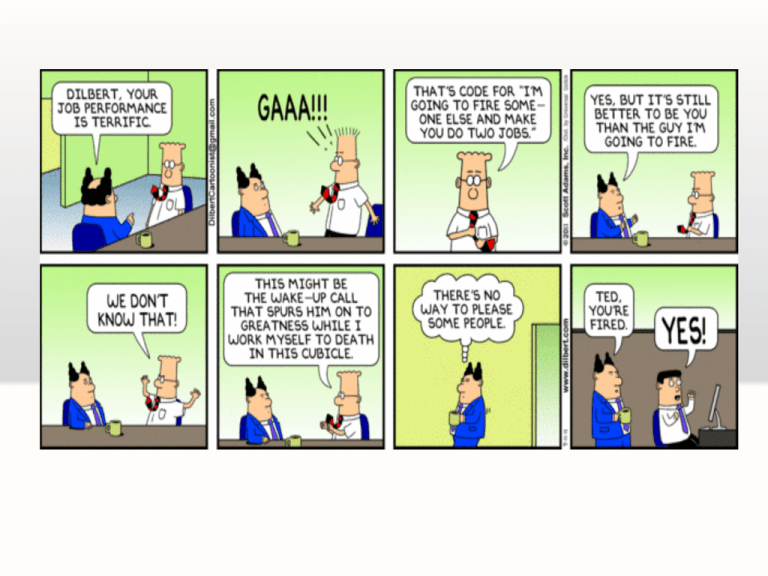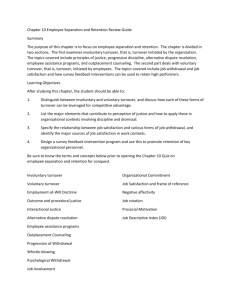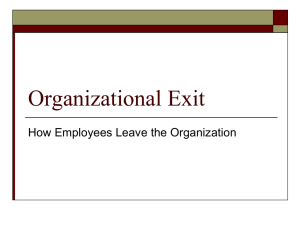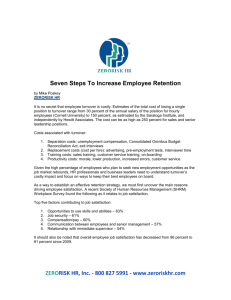
Chapter 6
Human Resource Decision
Making in Organizations
Learning Objectives
After studying this chapter, you should be able to:
1. Discuss the role of ethics in HR decision making
2. Describe the concept of and organizational strategies
for rightsizing
3. Describe how to manage termination and retention
4. Describe the elements of voluntary turnover
5. Discuss key HR issues during mergers and
acquisitions
© 2012 South-Western, Cengage Learning, Inc. All rights reserved.
6–4
Ethics and HRM
• Ethics
– Are an individual’s beliefs
about what is right and
wrong, and good and bad.
– Are formed by the societal
context in which people
and organizations function.
• Ethical Behavior versus
Legal Behavior
Rightsizing the Organization
The process of monitoring and
adjusting the composition of the
organization’s workforce to its
optimal size.
Increased Demand for Employees
Recruiting
& Hiring
Overtime
Temporary
Workers
Leasing
Part-Time
Workers
Declining Need for Employees
Reduce
Contingent
Natural
Attrition
Early
Retirement
Layoffs
Strategies for Layoffs Perceptions
Procedural
Justice
Distributive
Justice
Interactional
Justice
Employee
Reaction
to Layoff
Strategies for Layoffs – Legal
Issues
• Protecting Employee Rights
Layoffs could result in disparate impact
Decisions to layoff more senior employees
can result in age discrimination suits.
Layoff decisions related to performance must
be based on a defensible performance
appraisal process.
Worker Adjustment and Retraining
Notification (WARN)
Strategies for Layoffs – Legal
Issues
• Employers can defend themselves by:
• Demonstrating that the layoff was not simply a guise for
discrimination, but was based on genuine business concerns.
• Providing evidences of lagging sales, growing inventory, or a
depressed economy.
• Providing evidences of consideration to options such as
transferring employees into vacant positions, placing them in newly
created part-time positions, or allowing them to work a shorter
workweek.
• Claims of discrimination can also be refuted by statistical
evidence.
Is Downsizing Effective?
Managing Terminations and
Retention
Managing Involuntary Turnover
“Any time an employee is
terminated, it represents a
failure of some part of the HR
system.”
-Angelo Denisi
Managing Terminations and
Retention
Managing Involuntary Turnover
• Employee misconduct occurs when an employee
commits an infraction of workplace rules.
• Firms must implement discipline and discharge policies
for ensuring fair enforcement of those rules.
• Just cause : The cause of action should be a fair one.
• Due process: Employees should be informed of the charges
against them and be given an opportunity to defend themselves.
• Progressive discipline system: Discipline is enforced in
increasingly severe steps; starting with an oral warning and
ultimately termination.
Managing Terminations and
Retention
Managing Involuntary Turnover
Progressive
Disciplinary
Plans
Verbal
warning
Written
warning
Suspension
6–15
Termination
Managing Terminations and
Retention
Managing Involuntary Turnover
Discharge is usually considered a last
resort.
Employer must be able to prove that
the discharge was performancebased.
If required, employer must provide
other evidences such as adequate
documentation of poor performance
or efforts taken by manager to
improve substandard performance by
providing counseling
Managing Terminations and
Retention
Managing Involuntary Turnover
• Workplace rules:
• Organizations often impose rules to restrict certain
types of employee behaviors such as theft,
insubordination, drug use, or horseplay.
• Controversial workplace rules:
• No smoking rules: instituted for well-being of nonsmoking
employees, and financial reasons.
• Rules governing romantic relationships: instituted for
protecting trade secrets and avoiding appraisal bias;
approach taken by public- and private-sector employers vary.
• Employee misconduct outside the workplace.
Managing Terminations and
Retention
Managing Involuntary Turnover
• Employment-at-will
• Employers are free to discharge their employees for any reason,
even an unfair one, unless the discharge is limited by contract or
by federal or state statutes.
• Exceptions to the employment-at-will doctrine
• The public policy exception: Any doctrine that serves the needs of
society; if public policy is violated, society will suffer harm.
• The implied contract exception: An unwritten contractual agreement.
• The good faith and fair dealing exception: A common law prohibiting
discharges that are particularly repugnant or unfair.
Managing Terminations and
Retention
Managing Involuntary Turnover
Managing Terminations and
Retention
Managing Involuntary Turnover
• Preventing wrongful termination
• Avoid making any statements that promise long-term
employment.
• Include an at-will statement on the application form.
• Place a disclaimer in the employee handbook that the document is
provided as a matter of information only.
• Train interviewers to avoid making comments imply long-term job
security.
• Ensure that discipline and discharge practices are fair.
• Make sure the fairness of any discharge can be proven through
documentation.
Managing Terminations and
Retention
Managing Voluntary Turnover
• Job Dissatisfaction
– Is the feeling of being
unhappy with one’s job.
– Is a major cause of
voluntary turnover
• Job Embeddedness
Managing Terminations and
Retention
Managing Voluntary Turnover
A Model of the Turnover Process
Managing Terminations and
Retention
Managing Voluntary Turnover
Causes of Job Satisfaction/Dissatisfaction
Pay and Benefits
Job Security
Demographic
Factors
Opportunity For
Promotion
Recognition &
Appreciation
Interpersonal
Relationships
Opportunity To
Use One's Abilities
Working Hours &
Physical Conditions
Adequate
Authority & Sense
of Control
Equal Opportunity
Working
Environment
Managing Terminations and
Retention
Managing Voluntary Turnover
What are the Effects of Job Dissatisfaction?
Managing Terminations and
Retention
Managing Voluntary Turnover
How is Job Satisfaction Measured and Monitored?
Managing Terminations and
Retention
Managing Voluntary Turnover
What are some retention strategies?
It’s good to know that Catbert still loves his job…








